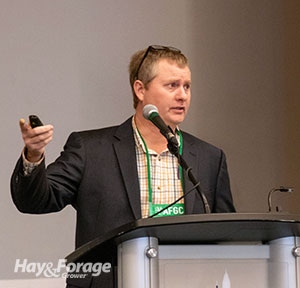
To Will Carter, Pintlala Creek is more than a scribbled line that runs through the middle of a map of Alabama — it is a symbol of environmental stewardship that borders his beef farm. Since Carter started implementing more sustainable practices, better water quality in the creek has been just one improvement he has seen across his entire grazing ecosystem.
Carter’s ancestors settled along Pintlala Creek in the 1830s, and members of the family have resided on the farmland ever since. Cattle occupied the grass pastures for a few generations as well until Carter’s grandfather passed away and all the animals were sold. It wasn’t until Carter and his wife, Monnie Carol, both graduated from veterinarian school and returned to the farm that the beef herd was re-established.
At the American Forage and Grassland Council’s Annual Conference in Mobile, Ala., Carter explained that he originally aspired to expand his beef enterprise in hopes of reaping higher returns. But when profits shrank despite a larger herd, he turned his focus toward soil health and forage growth for a more holistic approach to farm management.

“I started looking for things we could capitalize on, and the biggest advantage was that we can grow a lot of grass,” Carter said. “If we could manage the grass a little better and change the way we utilized it, we could go a lot further.”
Along with putting a greater emphasis on forage production, the Carters took a more intensive approach to rotational grazing, adjusted their beef genetics and breeding schedule, and installed fences and waterers in their pastures. For these efforts, Carter Cattle Company LLC received the National Cattlemen’s Beef Association’s (NCBA) Environmental Stewardship Award in 2022, and Carter continues to prioritize sustainable practices so that the next generation will inherit a more resilient system.
New ideas and investments
Carter’s perennial pastures include species like bahiagrass and tall fescue, but he also seeds cool-season annuals and clovers to enhance forage availability throughout the year. Dividing pastures into paddocks with polywire and rotating livestock according to plant growth has boosted forage availability by allowing greater rest periods between grazing events.
“We move cattle every two days in the spring, but we may extend that to a week in the fall,” Carter stated. “It just depends on what the grass is doing, what our goal for the pasture is, and what period of gestation our cows are in.”
In addition to using polywire, Carter also permanently fenced off most areas along Pintlala Creek to keep cattle from contaminating it. With less access to water for animals, he decided to install permanent water troughs in his pastures. He applied for Natural Resources Conservation Service (NRCS) cost-share programs and gained advice from conservation specialists to strategically place more than 25 water troughs in his paddocks over the past two decades.
“We don’t have square fields — every paddock is crooked and long with all kinds of corners,” Carter said. “If you don’t have good water, it’s hard to split those fields for grazing. NRCS stepped in an helped us with that, and their expertise has made the system last a lot longer.”
Investing in this infrastructure and implementing rotational grazing has effectively cut Carter’s yearly hay requirements in half; however, he still makes some ryegrass hay for winter feeding. Even so, less hay production has consequently lowered farm labor demands and slashed the amount he has had to spend on supplemental feed.
“Anything that we did to reduce the amount of time that we were in the tractor or spent feeding cows was a huge advantage,” Carter asserted.
Digging deeper
While the environmental and financial benefits of rotational grazing were apparent to Carter from the start, he noticed improvements to soil health over time. Regular soil testing has revealed higher soil nutrient levels, more soil organic matter, and a better soil pH since he has shifted his perspective on production.
“The biggest thing for me was the realization that it all starts with soil health,” Carter said. “If we focus on soil health, and then we worry about the grass, and then we worry about the cattle, all the pieces come together better.”
In other words, Carter resolved to make his cattle work with his system instead of making his system work for his cattle. For example, he pushed his fall-calving schedule later into the winter to avoid grazing unproductive summer pastures.
“We realized that if we were asking a cow to calve in October, we were carrying that lactating cow through the fall on low-quality grass,” Carter said. “We were asking her to do something she can’t, and we were not making the best use of our forage.”
Now Carter feeds ryegrass hay after calving, which he has found to be an efficient way to meet animals’ nutrient needs. Not only has the herd maintained its pregnancy rate and weaning rate despite different forage usage, but pounds per acre weaned went up significantly.
Carter analyzes the effects any change in management has on his operation, but perhaps the greatest effects have come from his change of view. More cows might not have been the answer for growing Carter Cattle Company LLC, but Carter’s newfound affinity for sustainability has resulted in more forage, more biodiversity, and more opportunities to continue his family’s farming legacy.
“You can define long-term success in a lot of different ways, but for us, it’s about sharing our passion with the next generation,” Carter affirmed. “It’s about building a system, creating a foundation, and giving them the tools to be successful.”

